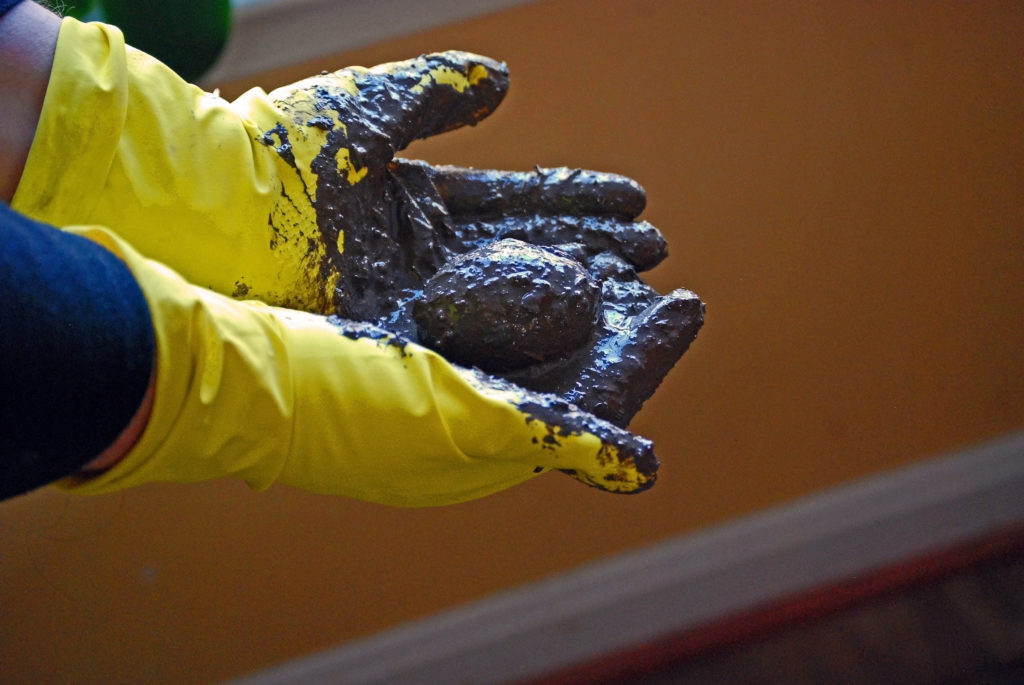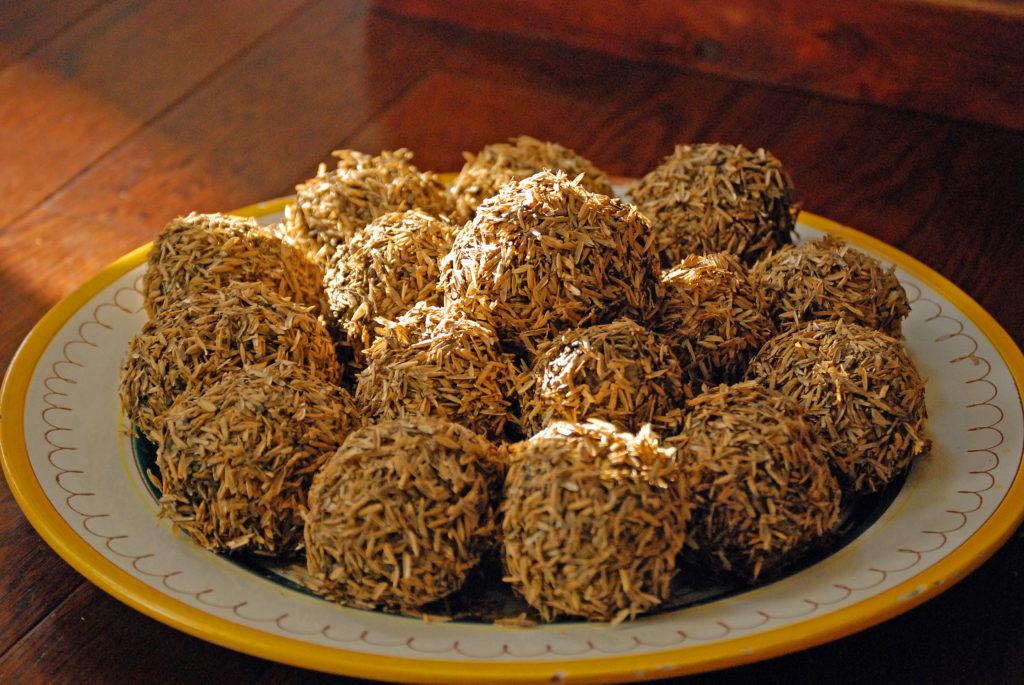So, as promised, I spent several hours yesterday making 1000 Year Eggs. That is, I coated a dozen and a half duck eggs with caustic mud, rolled and pressed them in rice chaff, and set them aside to dry. Later I placed them in a soil-lined ceramic crock and will let them sit for three to three-and-a-half months, before checking to see if I did it right. I’m sure if they start to rot instead of chemically change, we will be aware of it.
To start off, the eggs in the mud looked like this:

Then one thoroughly (and evenly) coats them with the mud:

And lastly, after they are covered with rice chaff, they look like this:

And now we wait. . . three whole months for the chemical conversions to take place inside the egg. After the ingredients to make pidan are mixed, the following chemical reactions take place:
CaO + H2O -> Ca(OH)2
Ca(OH)2 + Na2CO3 -> 2NaOH + CaCO3
Na2O3 + H2O -> 2NaOH + O2
K2O + H2O -> 2KOH
*The Na2O3 and K2O are from the plant ash
Because of the porosity of the egg shell, NaOH is first adsorbed to the surface, and, owing to a change in the osmotic pressure, NaOH enters the egg through the pores and subsequently penetrates the semi-permeable membrane, coming into contact with the egg protein, causing it to become denaturized and hydrolyzed into polypeptides and finally into amino acids.
The result is that 1000 Year Eggs are much higher in protein and much lower in carbohydrates than unpreserved duck eggs. Other nutritional elements such as amino acids and fatty acids are about equal between the two egg forms, although the preserved egg generally has a bit less of everything in it.
1000 Year Eggs
Ingredients
3 – 4 cups black tea brewed very strong + strained tea leaves
2/3 cup sea salt
3 cups wood ash
3 cups charcoal ash
1 ¾ cups quicklime
18 fresh duck eggs
2-3 pounds rice chaff
Latex gloves
I procured all of the ingredients from internet retailers except the wood and charcoal ash which our neighbors were generous enough to donate to the project in exchange for a chance to taste the bounty of the experiment. We also had the sea salt and tea on hand.
Directions
Brew the tea. I used at least a cup of loose tea leaves for 8 cups of water (I did say strongly brewed, right?) Let the tea sit for at least an hour to get really strong. In the meantime, find a large, non-reactive vessel (like a plastic painter’s bucket or other very large and deep bowl) and put the salt, ashes and quicklime into the bowl. When the tea is done, add about 3 cups and stir well. Then strain the tea, preserving both the liquid and the solids and add the spent tea leaves to the mud mixture. If necessary, add more brewed tea until the mud is a thick, but not watery solution.
Put on latex or other protective gloves. The mud is caustic and will cause skin discomfort.
Place the first batch of eggs into the mud and coat them well. I let mine sit for about 15 minutes before moving on to the next step. Find a large, deep bowl and fill it with rice chaff. After the eggs have rested in the mud, take them up one at a time and make sure they are completely coated. I found that the mud was a bit sticky and almost serous and didn’t want to adhere to the surface of the shell. When the coating is more or less uniform, place the egg in the chaff. Wipe excess mud off of your gloves by scraping on the edge of the vessel holding the mud. Then take handfuls of chaff and cover the egg with it completely. Pick up the egg and put chaff on the reverse side if needed. Then lightly compress the egg in your hand to try to get the chaff to bond with the mud. Remember the egg is raw and don’t squeeze too hard. When the chaff fully coats the egg (add more chaff if necessary), set it on a plate and move onto the next egg.
When all of the intended eggs are coated with mud and chaff, clean up. I let my eggs sit overnight before burying them in soil and lime. I used soil from outside (not potting soil) to fill the crock to get some natural microorganisms in the mix. If you have a choice of soils around your yard, use one with a high clay content. Set crock in an out-of-the-way place outside and wait a few months. I placed my eggs in a decorative sort of crock and put the crock in the garden as an ornament. Water is crucial to the process and the crock needs to be open to the rain to get wet and dry in cycles.
The reaction that causes the preservation proceeds more rapidly in warmer weather than in colder weather, so I will be waiting the full 100 days before checking on the eggs. Then you can look forward to posts exploring the flavor of these, wonderful ancient delicacies. (Words and recipe by Laura Kelley; All Photos by Laura Kelley)

This is a greatly informative article!
1) Where can I buy food grade quicklime?
2) Can I use hydrated lime instead?
3) Can I use all wood ash instead of charcoal ash?
Thanks
I love how you include the chemistry!! How did you come across all of that science, it really is so interesting and cool to learn about. Reminds me of when I was younger and watched Alton Brown’s Good Eats
My mom came from Shantung province. She talked about Thousand year eggs, but she made ordinary black tea eggs soaked for days in the fridge.
Must I use RICE CHAFF? Will straw or hay or chopped corn husks work?
Can I use Garden Lime?
Why do some instructions use the fruit (lime)?
Hi Mei:
You might be able to use some other roughage, I don’t think rice chaff is chemically relevant to making 1000-year eggs. I just posted the recipe I tried and that worked for me. As to why some recipes use the fruit lime, I think it is a misunderstanding of the meaning of “lime.” The right form of lime will matter to the transformation of the eggs because garden lime “sweetens” the soil, which means that it raises the pH and makes it less acidic. Good luck, and I would try to make the eggs before it gets too hot, or wait again until late summer/early autumn when temps go back down.
Good luck! Laura